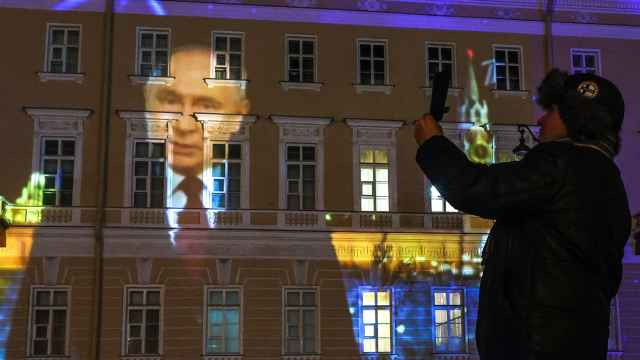BAIKONUR, Kazakhstan — A three-man space crew blasted off Tuesday in pre-dawn darkness, riding into orbit on a Soyuz craft emblazoned with the portrait of the first man in space in celebration of the 50th anniversary of Yury Gagarin's historic flight.
As the Soyuz TMA-21 launched from the Baikonur Cosmodrome as scheduled at 4:18 a.m., it turned the darkness into broad daylight for several moments and warmed the chilly steppe of Kazakhstan with a bright orange glow.
About nine minutes into the flight to the International Space Station, officials announced that the spacecraft had successfully reached orbit.
"They're feeling very good. They're very happy," said U.S. astronaut Nicole Stott, who watched the launch from the viewing platform. Stott has been on two space flights, including the final mission of Space Shuttle Discovery, which landed March 9.
Live footage on NASA TV showed that a small stuffed dog hanging in front of the crew had begun to float, an indication of the weightlessness of space. The toy dog had been given to the Russian commander, Alexander Samokutyayev, by his daughter.
Mike Suffredini, head of the U.S. International Space Station program, said the launch went off completely as planned.
"It was perfect, quite appropriate for the anniversary," he said at Baikonur.
The launch from Russia's cosmodrome in Kazakhstan was the first for Samokutyayev and fellow cosmonaut Andrei Borisenko. The U.S. astronaut traveling with them, Ron Garan, had made one previous trip into space, on a U.S. space shuttle mission in 2008.
They are to travel for two days before joining three other astronauts already aboard the orbiting space laboratory: Russia's Dmitry Kondratyev, U.S. astronaut Catherine Coleman and Italy's Paolo Nespoli, who have been there since December.
Tuesday's launch was seven days shy of anniversaries of two space milestones: Gagarin's flight into orbit in 1961 from the same launch pad and the first flight of the U.S. space shuttle 20 years later.
Speaking to reporters the day before the launch, Garan noted how much space flight has changed since Gagarin was launched during the space race between the two Cold War superpowers.
"Fifty years ago, one nation launched one man, basically as a competition," he said. "Today, the three of us represent the many nations of the international partnership that makes up the International Space Station."
In line with a now 50-year tradition, the crew earlier this week visited the cabin where Gagarin spent his last night before his flight. The American astronaut admitted getting "a little bit of chills" when he visited the cabin, where all the furniture and even Gagarin's personal belongings have been kept intact.
Russian spacecraft are normally austere in their design, carrying only an identifying number. The decision to name the current mission's spacecraft after Gagarin and decorate it with his portrait shows the reverence with which he is held in the Russian space industry. The Soyuz also was painted with Gagarin's now famous line as he headed for the launch pad: "Poyekhali!" or "Let's go!"
In his final message on Twitter before setting out on the six-month mission, Garan said: "Thanks to everyone for all the words of encouragement. They really mean a great deal to me. Final preps are in work. We're ready!"
Garan wrote earlier Tuesday on Twitter that he had picked U2's "One" and Dire Straits' "Brothers in Arms" as music to listen to during the flight.
Garan's backup, Daniel Burbank, used Garan's Twitter account to post photos of the launch preparations.
One of them showed the American astronaut following a Baikonur tradition and leaving his name on the door of his hotel room.
Garan has promised to keep sending Twitter messages and blogging at Fragile Earth, a shared blog written by several astronauts.
NASA is retiring its 30-year-old space shuttle program with Shuttle Endeavor's flight April 19 and the final trip of Atlantis this summer. After that, Soyuz will be the only means to carry astronauts into space.
Suffredini said he has "absolutely all the confidence in the world that Soyuz is doing the job" but would like the United States "at some point to evolve to have its own capability in human's lowest orbit," which, he said, American scientists are working on.
A Message from The Moscow Times:
Dear readers,
We are facing unprecedented challenges. Russia's Prosecutor General's Office has designated The Moscow Times as an "undesirable" organization, criminalizing our work and putting our staff at risk of prosecution. This follows our earlier unjust labeling as a "foreign agent."
These actions are direct attempts to silence independent journalism in Russia. The authorities claim our work "discredits the decisions of the Russian leadership." We see things differently: we strive to provide accurate, unbiased reporting on Russia.
We, the journalists of The Moscow Times, refuse to be silenced. But to continue our work, we need your help.
Your support, no matter how small, makes a world of difference. If you can, please support us monthly starting from just $2. It's quick to set up, and every contribution makes a significant impact.
By supporting The Moscow Times, you're defending open, independent journalism in the face of repression. Thank you for standing with us.
Remind me later.






